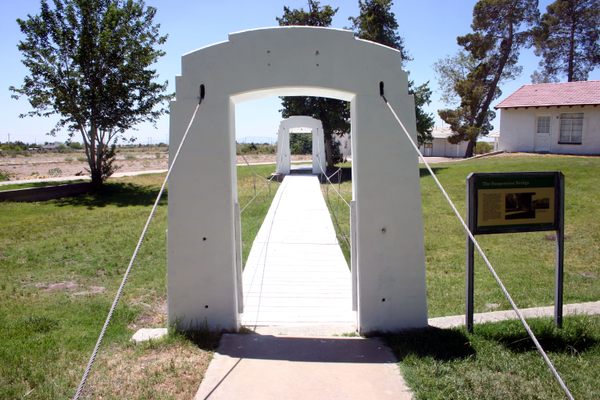Hidden Forest Trail
A spring and an enigmatic cabin lie in a ponderosa pine forest in the heart of the Desert National Wildlife Refuge.
One of the few “official” trails in the Desert National Wildlife Refuge, this path follows an old Jeep road some 5.5 miles up into the Sheep Range. It goes all the way from the low-desert Joshua tree-creosote bush biome in the valley beyond the range front to a ponderosa pine forest, the “Hidden Forest.” The route follows a rugged, scenic canyon flanked by limestone spires and cliffs. An old cabin sits at the end of the trail, as well as Wiregrass Spring, one of the few perennial springs in the refuge.
This cabin had been the subject of fanciful stories over the years. Some claimed it dated back to the 19th century, or that it was a bootlegger’s hideout during Prohibition, or a prospector’s camp. The actual backstory on the cabin was only elucidated in 2019, by researchers using contemporary accounts preserved in the archives of newspapers in Las Vegas and at the University of Nevada, Las Vegas. It turns out to be as colorful—and as sad—as any fictional tale.
Clarence Russell was a shell-shocked veteran of World War I, suffering from what is now called Post-Traumatic Stress Disorder. Russell homesteaded the site in 1931, apparently trying to escape into the quiet of the wilderness environment. In June 1932, however, while visiting another ranch seven miles away at White Rock Springs, he got into a violent argument and shot and killed C.P. “Red” White. He then tried to shoot White’s son, who managed to arm himself and kill Russell first. Although the murder was the subject of some notoriety in Las Vegas for a while, Russell’s story was rapidly forgotten.
The cabin was never officially registered as a homestead and so remained in Federal hands. When the wildlife refuge was created in 1936, the cabin saw some use as a temporary headquarters, or as a base from which the Refuge could be patrolled on horseback. With the construction of the permanent headquarters at Corn Creek, however, it fell into disuse. The cabin wasn’t finally designated a historic site until 1975.
Know Before You Go
The area lies completely within the Desert National Wildlife Refuge, which is focused on maintaining a wilderness environment for wildlife. In general please practice Leave No Trace ethics. Dogs on lead are OK, but fires and off-road vehicle travel are prohibited.
To get to the trailhead, take the Alamo Road 14.8 miles from Corn Creek to the Hidden Forest turnoff, at 36.63496 N, 115.35352 W. From here it is 3.7 miles to the trailhead, which is right at the range front, at about 36.6289 N, 115.28775 W. The road is blocked to vehicle traffic beyond this point (Google Maps incorrectly shows the road continuing into the canyon).
The hike to the cabin is straightforward, if a bit strenuous especially due to rocky and uneven footing on the canyon floor. In many places the old road has been completely obliterated by flash flooding, but route-finding is easy: just stay in the main drainage. The trail itself is completely waterless, so be sure to bring adequate amounts, especially in the warm months.
Wiregrass Spring, as one of the handful of water sources in the Refuge, can be used as a water source, but of course requires treatment. It also has been unreliable in recent years; check at the Corn Creek Visitor Center beforehand if you're planning on refilling from it. Also, please camp such that wildlife has easy access to the spring; it is even more important as a water source for them!
Please don't enter the cabin; it is a historic site, not an overnight lodging.
Hidden Forest/Wiregrass Spring is also the usual jumpoff point for ascents of Hayford Peak (9,920 feet/3,024 meters), the high point in the Sheep Range, which is about three miles north and some 1800 feet higher. Typically climbers backpack to Hidden Forest and then climb the peak the following day.
This is a strenuous ascent in rugged, completely waterless terrain with no defined trail. It should be attempted only by experienced backcountry climbers.













Follow us on Twitter to get the latest on the world's hidden wonders.
Like us on Facebook to get the latest on the world's hidden wonders.
Follow us on Twitter Like us on Facebook